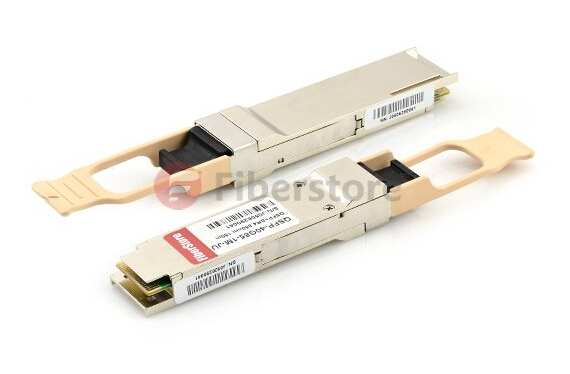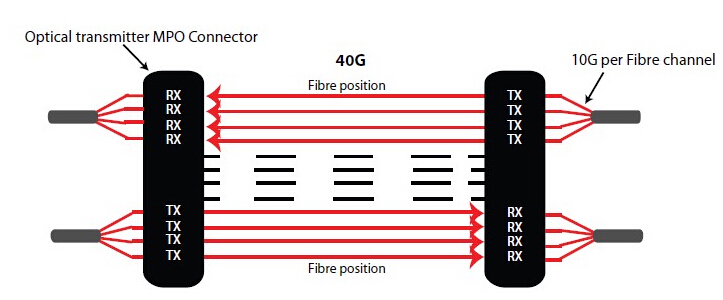To meet the needs of Internet users, the business users in particular, who require faster speeds, greater scalability, and higher levels of network performance and reliability, data centers have experienced infrastructure transformation, from 10 Gbps to 40 Gbps and then to 100 Gbps, or even higher, never-ceasing. Actually, during this bandwidth migration, 40G provides an efficient use of hardware and a more logical upgrade path to 100G. And in establishing 40G links, fiber optic cabling, (eg OM3 and OM4) has become an integral part of the overall system design.
The Institute of Electrical and Electronics Engineers (IEEE) 802.3ba 40/100G Ethernet Standard was ratified in June 2010 to support the fast-growing demands for bandwidth in data centers. The standard provides specific guidance for 40G/100G transmission with multi-mode fibers (MMFs) and single-mode fibers (SMFs). OM3 and OM4 are the only approved multi-mode fibers included in this standard.
The IEEE 802.3ba only specified OM3 for a maximum reach of 100 m in its original draft. Later, efforts have been made to win the approval to include OM4 in the standard. As a matter of fact, OM4 can achieve the greater reach of 150 m compared with OM3. In 40 GbE transmission which uses MMFs, an optic module interface is used for the simultaneous data transmission and data reception. Like JNP-QSFP-40G-LX4, this Juniper Networks proprietary 40G-LX4 transceiver listed on FS.COM realizes 100 m transmission on OM3, and 150 m transmission on OM4. Besides, JNP-QSFP-40G-LX4 can also run over SMF for 2 km link lengths.

When evaluating the performance of the OM3 and OM4 cabling infrastructure for 40GbE transmissions, three aspects should be taken into consideration: bandwidth, channel connector insertion loss (CIL) and skew.
- Bandwidth
In the standard, the bandwidth is ensured by meeting the effective modal bandwidth (EMB) specification. The EMB measurement techniques utilized nowadays are effective modal bandwidth calculate (EMBc) which combines the properties of both the source and fiber. The EMBc process predicts source-fiber performance by integrating the fundamental properties of light sources with the MMF’s modal structure which has been measured using a standardized differential modal delay (DMD) measurement. Within 40G links using OM3 and OM4 fibers measured by the EMBc technique, the optical infrastructure shall meet the performance criteria set forth by IEEE for bandwidth.
- Channel Insertion Loss (CIL)
CIL is a critical performance parameter in current data center cabling deployments. It refers to the total insertion losses that happen when the signal moves along a fiber optic cable. Within a system channel, CIL impacts the ability to operate over the maximum distance at a given data rate. With total connector loss increasing, the maximum distance at that given data rate decreases. The 40/100G standard specifies the OM3 to a 100m distance with a maximum channel loss of 1.9dB, while OM4 is specified to a 150m distance with a maximum channel loss of 1.5dB.
- Skew
Skew is classified as the difference between the arrival times of simultaneously launched light signals traveling through parallel cable lanes. When evaluating OM3 and OM4 performance for 40applications, selecting one that meets the 0.75ns skew requirement can ensure the performance.
40G is deployed using eight of the twelve fibers in a MPO connector. Four of these eight fibers are used to transmit while the other four to receive. Each Tx/Rx is operating at 10G. The 40GBASE-SR4 (eg. QFX-QSFP-40G-SR4) interface is as follows: 4 x 10G on four fibers per direction.

OM3 and OM4 for 40G connectivity provide a significant value proposition when compared to SMF, as MMF utilizes low cost 850nm transceivers for serial and parallel transmissions. OM3 and OM4 ensure today’s bandwidth needs.
To continue to accommodate the bandwidth needs, OM3 and OM4 are the ideal solution for 40G links in the data center. FS.COM offers broad selections of OM3 and OM4 fibers of high quality, as well as fiber optic transceivers working over OM3 and OM4, such as JNP-QSFP-40G-LX4 and QFX-QSFP-40G-SR4 mentioned above. You can visit FS.COM for more information about OM3 and OM4, MMF.


